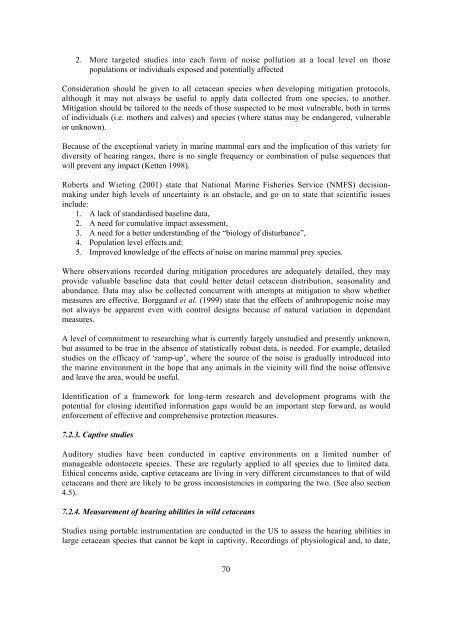Oceans of noise - Whale and Dolphin Conservation Society
Oceans of noise - Whale and Dolphin Conservation Society
Oceans of noise - Whale and Dolphin Conservation Society
- No tags were found...
You also want an ePaper? Increase the reach of your titles
YUMPU automatically turns print PDFs into web optimized ePapers that Google loves.
2. More targeted studies into each form <strong>of</strong> <strong>noise</strong> pollution at a local level on thosepopulations or individuals exposed <strong>and</strong> potentially affectedConsideration should be given to all cetacean species when developing mitigation protocols,although it may not always be useful to apply data collected from one species, to another.Mitigation should be tailored to the needs <strong>of</strong> those suspected to be most vulnerable, both in terms<strong>of</strong> individuals (i.e. mothers <strong>and</strong> calves) <strong>and</strong> species (where status may be endangered, vulnerableor unknown).Because <strong>of</strong> the exceptional variety in marine mammal ears <strong>and</strong> the implication <strong>of</strong> this variety fordiversity <strong>of</strong> hearing ranges, there is no single frequency or combination <strong>of</strong> pulse sequences thatwill prevent any impact (Ketten 1998).Roberts <strong>and</strong> Wieting (2001) state that National Marine Fisheries Service (NMFS) decisionmakingunder high levels <strong>of</strong> uncertainty is an obstacle, <strong>and</strong> go on to state that scientific issuesinclude:1. A lack <strong>of</strong> st<strong>and</strong>ardised baseline data,2. A need for cumulative impact assessment,3. A need for a better underst<strong>and</strong>ing <strong>of</strong> the “biology <strong>of</strong> disturbance”,4. Population level effects <strong>and</strong>;5. Improved knowledge <strong>of</strong> the effects <strong>of</strong> <strong>noise</strong> on marine mammal prey species.Where observations recorded during mitigation procedures are adequately detailed, they mayprovide valuable baseline data that could better detail cetacean distribution, seasonality <strong>and</strong>abundance. Data may also be collected concurrent with attempts at mitigation to show whethermeasures are effective. Borggaard et al. (1999) state that the effects <strong>of</strong> anthropogenic <strong>noise</strong> maynot always be apparent even with control designs because <strong>of</strong> natural variation in dependantmeasures.A level <strong>of</strong> commitment to researching what is currently largely unstudied <strong>and</strong> presently unknown,but assumed to be true in the absence <strong>of</strong> statistically robust data, is needed. For example, detailedstudies on the efficacy <strong>of</strong> ‘ramp-up’, where the source <strong>of</strong> the <strong>noise</strong> is gradually introduced intothe marine environment in the hope that any animals in the vicinity will find the <strong>noise</strong> <strong>of</strong>fensive<strong>and</strong> leave the area, would be useful.Identification <strong>of</strong> a framework for long-term research <strong>and</strong> development programs with thepotential for closing identified information gaps would be an important step forward, as wouldenforcement <strong>of</strong> effective <strong>and</strong> comprehensive protection measures.7.2.3. Captive studiesAuditory studies have been conducted in captive environments on a limited number <strong>of</strong>manageable odontocete species. These are regularly applied to all species due to limited data.Ethical concerns aside, captive cetaceans are living in very different circumstances to that <strong>of</strong> wildcetaceans <strong>and</strong> there are likely to be gross inconsistencies in comparing the two. (See also section4.5).7.2.4. Measurement <strong>of</strong> hearing abilities in wild cetaceansStudies using portable instrumentation are conducted in the US to assess the hearing abilities inlarge cetacean species that cannot be kept in captivity. Recordings <strong>of</strong> physiological <strong>and</strong>, to date,70




